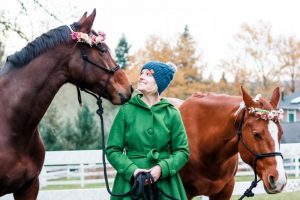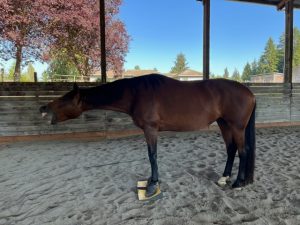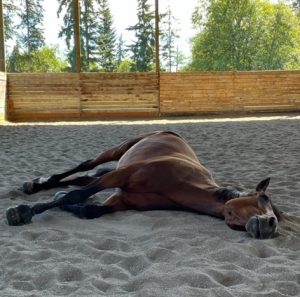 Editor’s Note:
Editor’s Note:
Best Horse Practices Summit steering committee member Marika Saarinen is a horse enthusiast and human to two mares. She loves classical dressage, cross country, and trail riding near her Washington home. She holds a Doctor of Pharmacy and consults for health care companies along with helping her engineer husband run his business.
Marika’s experience in health care helps her have empathy for the horse. She understands that as we learn more, we need to change and rethink horse-keeping practices as needed. This is a big reason why she is excited to be part of BHPS.
In this guest column, Marika chronicles the rehabilitation journey of her mare, Senja, after Kissing Spine surgery.
Marika writes:

Along the rehab journey
Rehabilitation is one of the loneliest journeys I know. It is a manic-depressive roller coaster, shooting you up one day with the progress, and down, down, down into ugly crying the next.
But – and there is always a but – there is hope. Some days it comes as a lip twitch or a look in your direction; other days it’s bigger, as a sigh or wet shower of snort.
Since April, I have been rehabbing my horse after her kissing spine surgery. This is the first time I have publicly shared the journey. I told a few close friends and our therapists, of course. But mostly, I haven’t had the capacity to handle other people’s opinions. My horse was fragile, and I have been, too. I needed to guard my heart ferociously so I could give all to her.
My mare, Senja (Sen-yah, a Finnish name meaning “welcoming” or “hospitable”) is my dream horse. When I saw her for a short test ride, she was a six-year-old bay Trakehner mare, standing 16 hands. It was meant to be. I had wanted her exactly.
She passed her vet check with the caveat that her feet were quite bad, which was contributing to some soreness. But the vet assured me she would be okay with proper care. I was too in love to disagree, and she came up to Washington from California last October.
Our problems started in December when she colicked while I was in Finland. I got the call from the barn owner while shopping in Helsinki, and I ran out of the store and into the street, hysterical and not being able to breathe. An old mare who came up from California with Senja had died from colic a couple months prior. Now it was happening to my horse. I stayed up the next 24 hours, waiting for updates, talking to vets, praying hard. She pulled through.

Slow progress
When I came back from my trip, I was at the barn every day, making sure she drank water, monitoring her temperature, and watching over her. A couple weeks passed, but she was very unhappy. She bit me, and then she bit my husband. I feared ulcers and started treatment after the okay from a vet.
By early February, Senja had improved, but she still took a step forward when I lifted her saddle. She started to lose her topline, and her feet were not improving.
Something was still amiss. I called my vet. She x-rayed her back and became quiet when she looked at them. When she asked, “Do you want to take a look?,” I started to cry. “We’re going to
surgery aren’t we?” I said.
On April 13, she had surgery.
Jec Ballou wrote us a post-surgery program, which I followed as best as I could:
We walked poles, took neighborhood hill walks, and trailered to the trails to walk from the ground.
The chiropractor and the massage therapist came. I was able to get her feet rehabbed with good trims and glue-on shoes.
Recently, we switched to acupuncture and structural integrative therapy. She is responding nicely.
 I have moments when I tell my husband that my horse just doesn’t like me. He reminds me that I’ve told him that’s not how horses work. My horse still walks away from me when I go to get her with a halter in my hand. Some days it hurts despite my trying not to take it personally. I’m only human.
I have moments when I tell my husband that my horse just doesn’t like me. He reminds me that I’ve told him that’s not how horses work. My horse still walks away from me when I go to get her with a halter in my hand. Some days it hurts despite my trying not to take it personally. I’m only human.
Pain is a strong memory for her and I think haltering is the first step to a previous life of pain. I’m reminding myself of this every time I pick up her halter.
This past week, though, there has been a shift. I held space with my hands lightly at her left shoulder and I took a deep exhale. She yawned. I told her I’m going to stop treating her as a surgical case and start treating her
more as a horse in the moment. We knocked cones off a barrel for fun (bowling for horses!) and stretched in some new ways. I breathed into my lower back and watched her lip stretch longer and longer.
Today after I released her out of a stretch, she took a few steps and dropped onto the arena sand. Within minutes, she was lying on her side, snoozing happily. When she woke up from her nap, I got the halter and held it up close to her nose. She lowered her head into it.
What I have learned with rehab:
- Lean into the mess and into the ups and downs of it all.
- On days you are sad, feel the sadness.
- On days you are happy, feel that happiness.
- Share space and explore the ideas of riding again, but leave any dates out of it.
When we talk about pressure to a horse, it exists as small as a thought we have in the back of our minds. Catch it and shape it in a different form. Remember that you are not alone in the journey. Your horse is right there with you every step of the way.
So very happy your journey with your mare is improving so much. Lovely article, sharing your hurt and your joys with us, thank you.
Wonderful article. Thank you for sharing.